What is the difference between barley, wheat and other grains
In the healthy eating pyramid, an important place is given to products made from grain: bread and various cereals. They account for a significant portion of carbohydrates consumed by humans, so the problem of choosing the most healthy cereals is especially relevant.
Of all the grain crops, the most popular are wheat, barley, rye and oats. They differ not only in appearance, but also in composition, nutritional value and properties.
Characteristics of cereals
The benefits of a product are determined by its nutritional, energy value and vitamin and mineral composition.
Wheat
Wheat - one of the oldest cultivated plants. The first mentions of its cultivation date back to the 9th–6th millennia BC. e. Today it is the No. 1 cereal in many countries.
Of all grains, wheat has the greatest variety of varieties, but from the point of view of application, the division into soft and hard plays an important role. The energy and nutritional value of grain depends on this. Durum wheat contains slightly more protein (13 g vs. 11.8 g in soft wheat) and fiber (11.3 vs. 10.8), but fewer carbohydrates (57.5 vs. 59.5). The amount of fat is about 2.5 g, calorie content is 305 kcal.
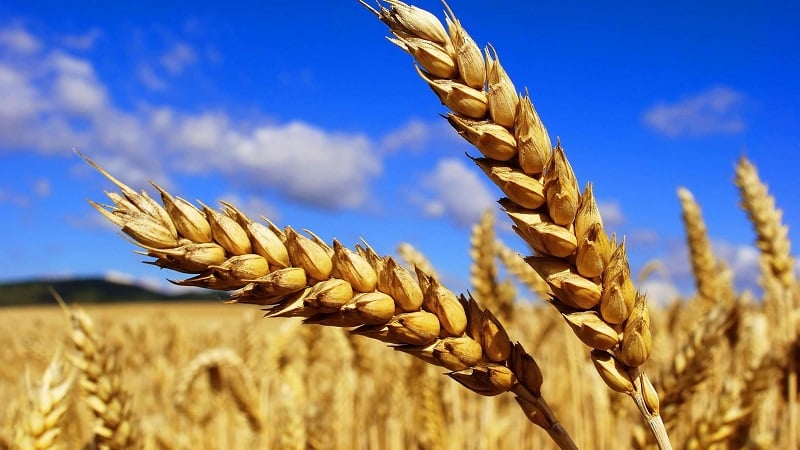
The chemical composition is rich. 100 g of product contains:
- manganese - 188% of the daily value;
- silicon - 160%;
- cobalt - 54%;
- selenium - 52.7%;
- copper - 47%;
- phosphorus - 46.3%;
- molybdenum - 33.7%;
- iron - 30%.
The cereal has a high content vitamins PP (39%), B1 (29.3%), E (20%), B6 (18.9%).
Attention! The most valuable part of a wheat grain is the germ. Sprouted grain is healthier and contains oil with a higher content of biologically active components.
Barley
The cultivation of this plant began approximately 10 thousand years ago. Although the food importance of barley began to decline by the 19th century, today it ranks 4th in the world in terms of cultivated area after wheat, corn and rice.

The calorie content of unprocessed barley grain is 288 kcal.
Nutritional value:
- 10.3 g proteins;
- 2.4 g fat;
- 56.4 g carbohydrates;
- 14.5 g fiber.
Husked grain contains 354 kcal, it is richer in protein (12.5 g) and dietary fiber (17.3 g).
Chemical composition of cereal (per 100 g):
- silicon - 2000% (20 times the daily intake);
- cobalt - 79%;
- manganese - 74%;
- copper - 47%;
- phosphorus - 44%;
- iron - 41%;
- selenium - 40.2%;
- magnesium - 37.5%.
Of the vitamins, barley contains the most PP (32.5%), B6 (23.5%), biotin, B1 and B4 (22% each).
Rye
Initially, rye was considered as a weed plant in wheat and barley crops, therefore its cultivation occurred around the 2nd millennium BC. e. The cold-resistant and unpretentious grain was cultivated mainly by northern peoples: the Scythians (IX–III centuries BC), and later the Slavs and farmers of Northern Europe.
Gradually, rye became a widespread cereal, but even in the 21st century, the vast majority of world production came from Germany, Russia and Poland.

Whole, unprocessed grain contains 283 kcal. Nutritional value:
- 9.9 g protein;
- 2.2 g fat;
- 55.8 g carbohydrates.
Cereal contains a large amount of dietary fiber — 16.4 g, that is, 100 g of product satisfies a person’s daily fiber requirement by 82%.
100 g of rye are rich in substances such as:
- silicon - 283.3% of the daily value;
- manganese - 138.5%;
- cobalt - 76%;
- copper - 46%;
- selenium - 46.9%;
- phosphorus - 45.8%;
- iron - 30%;
- magnesium - 30%;
- molybdenum - 25.7%.
Cereal is a source of vitamins B, especially B1, B5 and B6. They contain from 17 to 25%.
Oats
This is a relatively young culture, which began to be cultivated no earlier than the 2nd millennium BC. uh. Like rye, oats were long considered a weed that infested spelled crops, but gradually moving into northern latitudes, they replaced more heat-loving cereals and began to be widely cultivated in many European countries.
Reference! In the harsh climate of Great Britain, especially Scotland, oats were an important part of the diet. They baked cakes from flour, prepared porridges and puddings. In Bavaria (Germany), despite the legal ban, oat beer was brewed. In Rus', the usual food of the population was oatmeal and oatmeal jelly.
The grain has the highest calorie content among the cereals under consideration. - 316 kcal. Contains a lot of fat (6.2 g) with a moderate amount of protein (10 g) and carbohydrates (55.1 g). Dietary fiber per 100 g of product - 12 g.
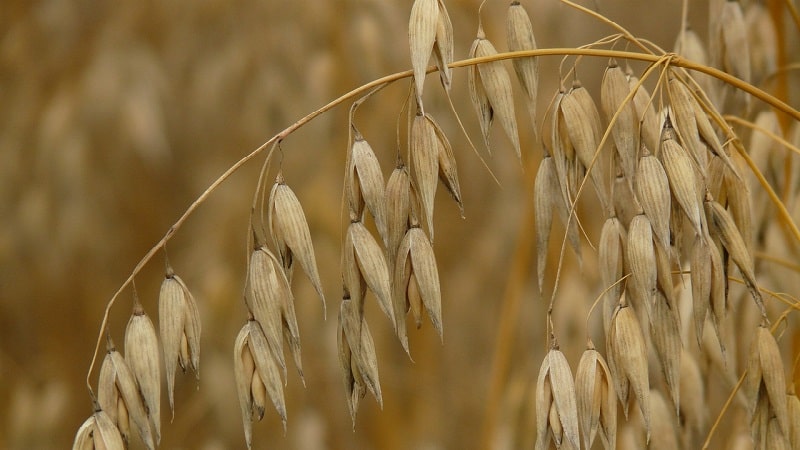
Oats are the leader in silicon content: 1000 mg in just 100 g of grain (this is 3333.3% of the daily value). He is rich:
- manganese - 262.5% of the daily value;
- cobalt - 80%;
- copper - 60%;
- molybdenum - 55.7%;
- selenium - 43.3%;
- phosphorus - 45.1%;
- magnesium - 33.8%;
- iron - 30.6%;
- zinc - 30.1%.
Contains vitamins B1 (31.3%), H (30%), B4 (22%), B5 and RR (20% each).
Reference! Silicon is of great importance in collagen synthesis.
Similarities and differences between wheat, barley, oats and rye
All plants belong to the Poaceae or Poa family. Despite the family connection, there are significant differences between them both in appearance and properties.
By appearance
Seedlings of wheat, barley and oats are practically indistinguishable from each other. Rye has rose-red or bluish shoots that then turn pale green.
The stem of cereals is a hollow straw. Rye and oats have tall stems, barley is the shortest of them.
Interesting! There is a saying about the differences between oats and barley: “Oats talk, but rye listens.” Thus, folk wisdom noted the presence of two ears at the base of barley leaves, and reeds at the base of oat leaf sheaths. Rye and wheat leaves have both "organs".
The most obvious differences appear at the stage of formation of inflorescences—spikelets.. Thus, oats have a panicle, wheat has a tetrahedral ear. The inflorescences of barley and rye are almost identical in appearance, but after threshing, the rye grain remains naked, and the barley grain remains hidden in dense scales.
External differences in more detail wheat, rye, barley and oats are reflected in the table:
| Sign | Wheat | Barley | Oats | Rye |
| Number of growing seasons | annual | Annual, biennial or perennial | annual | Annual or biennial |
| Stem height | 45–150 cm | 60–80 cm | 50–170 cm | 80–100 cm |
| Stem | Erect hollow and naked | Straight naked straw | The straw is 3–6 mm in diameter, has 2–3 nodes | Hollow and glabrous, pubescent under the inflorescences, includes 5-6 internodes |
| Leaves | Flat linear or wide linear (up to 2 cm wide). At the place of transition from the leaf sheath to the leaf plate, they have lanceolate ears and a membranous tongue. | Linear, up to 30 cm long and 2-3 cm wide, flat, smooth. Ears form at the base of the plate. | Regular green or gray. Narrow (8–30 mm wide) and long (25–30 cm long). | Dove-gray, flat, broad-linear (15–25 mm), reaching 15–30 cm in length.At the base of the plate there is a short tongue and ears. |
| Inflorescences and spikelets | The spike is loose, two-row, tetrahedral. Has a flexible rod. The apex is formed by a short wide tooth. | A complex spike with lanceolate spikelets collected in steps (2-3) on a common axis. | Spreading or one-sided panicle up to 25 cm long. The axis of the spikelet is bare, the scales are long, two-toothed. | Elongated, slightly drooping ear. |
| Caryopsis | Oval, elongated-ovoid. It has a clearly defined crest and a longitudinal groove on the back. | Often fuses with the upper hymen. Has a wide groove. | Lightly pubescent, hidden in hard scales. | Oblong, laterally compressed. It has a deep groove in the middle. |
| Varieties | Hard and soft | Two-row and six-row, furcat | Membranous and naked | Rye |
By properties
The plants in question differ significantly in their requirements for soil, heat and humidity:
- Wheat prefers a warm continental climate. For seed germination, a temperature of +1...+2°C is required, for seedlings to emerge - +3...+4°C. Productivity is highly dependent on the length of daylight hours. The crop is capricious in terms of soil choice, the minimum humus content is 1.8%, pH is not lower than 5.8. Suitable for cultivation are soddy-podzolic, sandy loam, and, in extreme cases, peat-bog lowland soils. Durum wheat is exclusively spring wheat, and soft wheat is winter wheat.
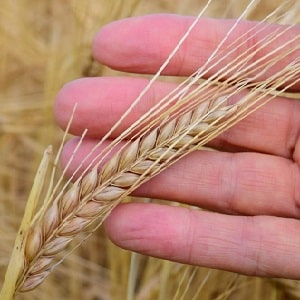 Barley differs from wheat in its unpretentiousness: thanks to the accelerated growing season, it has time to ripen in cold areas. Suitable for growing in high mountains and northern regions. It is frost-resistant, can withstand prolonged drought and is undemanding to soil composition.
Barley differs from wheat in its unpretentiousness: thanks to the accelerated growing season, it has time to ripen in cold areas. Suitable for growing in high mountains and northern regions. It is frost-resistant, can withstand prolonged drought and is undemanding to soil composition.- Oats are unpretentious to the climate; seedlings tolerate light frosts (up to -4...-5°C). The short growing season (80–120 days) allows the crop to be grown in the northern regions. At the same time, oats are moisture-loving; their yield decreases in dry years. Ideal locations: Northwestern Europe, Russia and Canada with short and rainy summers. It has an increased ability to absorb nutrients, including sparingly soluble potassium compounds.
- The root system of rye reaches 1-2 m in depth, making the crop the least demanding of all cereals. The plant actively absorbs nutrients from the soil, so it can grow even on humus-poor and acidic soils. As a winter crop, it is most winter-hardy and can withstand temperatures down to -19...-21°C. Another benefit of rye is cross-pollination. The crop is often grown as winter grain, insuring spring plantings of other grains.
Do they contain gluten?
Gluten, or gluten, is a special group of proteins found in cereal plants. This substance is one of the criteria for the quality of flour: it is responsible for the firmness and elasticity of the dough. Dry gluten improves lower quality flour; it is added to minced meat and pasta.
Reference! Vegetarian diets often use a product called seitan, a natural gluten-based substitute for animal protein.
There is a rare disease called celiac disease, or celiac disease.. Intolerance to foods containing gluten is associated with disruption of the small intestine. Celiac disease has different causes: the consequences of autoimmune diseases, an allergic reaction or a genetic predisposition. Patients are prescribed a gluten-free diet.
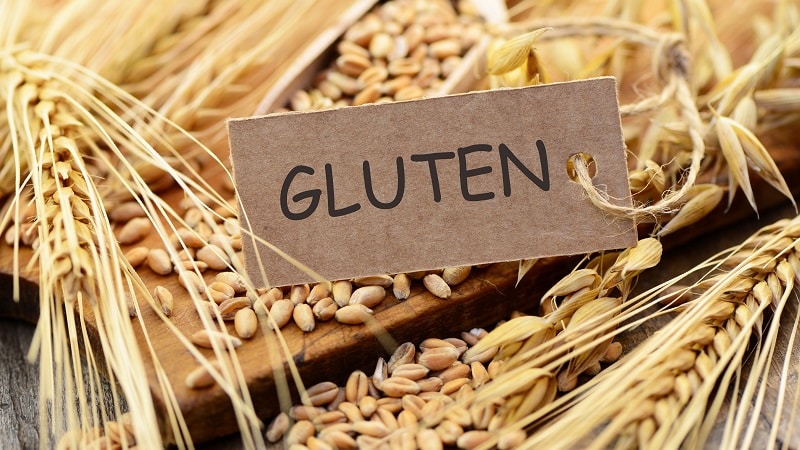
In relation to healthy people, the harm of gluten is due to the fact that as a result of the selection of more productive varieties of cereals, the gluten molecule has increased in size. Digesting it requires more enzymes - this increases the load on the stomach and intestines. Gluten that is not completely digested causes inflammation of the gastrointestinal tract and contributes to obesity.
Gluten is present in all four grains:
- Wheat is the richest in gluten - here it is 80% of the total protein content (when processed into semolina, the amount of gluten is reduced to 50%, in pasta - to 11%);
- barley contains 22.5% gluten, so products made from gluten-free flour, but using barley malt and molasses as a sweetener, are contraindicated for people with celiac disease;
- rye contains only 15.7% gluten.
The situation with oats. In its pure form, this cereal does not contain gluten., but due to the sowing of wheat in oat fields and as a result of cross-contamination, the proportion of gluten increases to 21% of the total protein content.
Beneficial features
Cereals have a positive effect on the human body and are used to treat various diseases.
Wheat
Wheat is an excellent source of energy. Cereal decoction with honey restores strength after long-term illnesses.
Unprocessed grains have a beneficial effect on the intestines:
- pectins absorb harmful substances and reduce putrefactive processes;
- fiber contains plant fibers - prebiotics, which promote the growth of beneficial microflora.
Wheat bran is rich in fiber, which makes them an effective means for normalizing weight, and poultices and decoctions of bran soften and nourish the skin.
Sprouting cereals facilitates the absorption of proteins, fats and carbohydrates contained in grains, and increases the concentration of vitamins and other elements tenfold.

Wheat germ has many beneficial properties:
- normalize acid-base balance;
- promotes better digestion, cleanses of toxins;
- act as an immunomodulator: increase the body’s resistance to the negative effects of the environment;
- stimulate metabolism and hematopoiesis;
- have antioxidant properties, prevent the action of free radicals, strengthen the walls of blood vessels and prevent cancer;
- when used externally, they have an anti-burn effect, accelerate the healing of wounds and ulcers, and are used as a rejuvenating agent.
It is better to buy wheat for germination in pharmacies or specialized stores. The germination procedure itself is simple: the grains are soaked in water for 2 days, then covered with a damp cloth for several days until sprouts appear. This product is added to salads or eaten as an independent dish. Store in the refrigerator for no longer than 48 hours.
Interesting! An external antiseptic “Mitroshin Liquid” is prepared from heat-treated grains of wheat, rye or oats, which is used for eczema, scaly lichen, neurodermatitis, purulent inflammation of the hair follicles (sycosis).
Barley
Cereal cleanses the body of harmful substances, improves digestion and promotes growth of beneficial bacteria in the intestines. Barley groats rich in β-glucan polysaccharide, which has a cholesterol-lowering effect.

In folk medicine, barley decoction is used to treat:
- respiratory organs for tuberculosis, pneumonia, pharyngitis, sore throat and bronchitis;
- gastrointestinal diseases, including ulcers, colitis, cholecystitis.
A decoction of grain flakes has has a diuretic effect, and the slimy drink helps with acute intestinal inflammation.
There is a whole a number of recipes for skin diseases and defects:
- the barley diet treats eczema, psoriasis and pyoderma;
- hot ointment gets rid of freckles;
- a dressing of cereal, vinegar and quince is used for gout;
- malt treats boils and pimples.
Plant widely used in cosmetology in the production of shampoos, balms, creams.
Rye
Rye grain and its derivatives have a whole set useful properties:
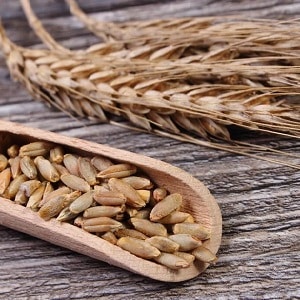 amino acids lysine and threonine promote tissue growth and repair;
amino acids lysine and threonine promote tissue growth and repair;- A decoction of cereal has an expectorant effect for bronchitis;
- sourdough rye bread is used as a laxative, and bran decoction is used as a fixative;
- kvass contains many vitamins, normalizes digestion and is good for the cardiovascular system;
- rye stalks are used to treat thyroid diseases;
- sprouts indicated for gastrointestinal diseases;
- Poultices made from warm rye dough are used to treat hard, painful tumors.
Products made from such flour have a low glycemic index, therefore they are included in the diet of patients with diabetes.
Oats
Oats are indispensable for exhaustion of the body:
- mucous decoctions and soups from cereals have an enveloping effect in acute inflammatory diseases of the gastrointestinal tract (gastritis, enterocolitis);
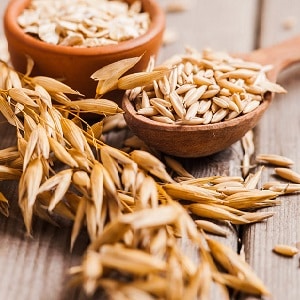 easily digestible proteins, fats and carbohydrates, B vitamins are indicated for intestinal atony, viral hepatitis, diseases of the nervous and cardiovascular systems, iron deficiency anemia;
easily digestible proteins, fats and carbohydrates, B vitamins are indicated for intestinal atony, viral hepatitis, diseases of the nervous and cardiovascular systems, iron deficiency anemia;- liquid oat stew acts as a tonic for tuberculosis;
- To normalize sugar levels, diabetics are given an infusion of unrefined grains to drink;
- plant tincture has sedative and hypnotic effects, it is also used as a carminative for flatulence;
- a decoction of cereals with honey has restorative properties and has a mild laxative effect;
- fresh straw is used for hot compresses for kidney stones, and baths relieve joint pain due to arthrosis;
- In experimental therapy, an alcoholic extract from young plants is included in the treatment of drug and tobacco addiction.
Cosmetic masks made from oatmeal and flakes cleanse the skin, and an alcoholic tincture of milk grains is used as a sedative for neurasthenia and insomnia.
Which is healthier?
The most common way to consume cereals is to use flour and cereals.
Leads in beneficial properties rye flour, especially peeled (whole grain): it contains a lot of fiber, potassium, magnesium, iron, phosphorus and calcium.
Interesting! According to historians, a large amount of proteins and amino acids in rye bread with natural sourdough helped Russian peasants maintain their body during Orthodox fasts and compensated for the lack of meat in the diet.
Baking made from wholemeal rye flour is indicated for diabetes mellitus, as it contains slow carbohydrates and does not cause spikes in blood glucose.
Barley and oat flour are rarely used without the addition of wheat: their gluten is not enough for the elasticity and fluffiness of the dough.
Among the cereals, the most useful are barley and oat flakes. (Hercules). Barley is an unpolished grain that has partially retained the bran shell.Therefore, in terms of the amount of fiber (8 g), it is ahead of oatmeal (6 g), and contains more calcium and folic acid. Pearl barley contains an even greater amount of dietary fiber (15.6 g), but it is poorer in vitamin and mineral composition. Barley protein is almost completely absorbed by the body, and slow carbohydrates provide a long-lasting feeling of fullness.
Oatmeal is a storehouse of vitamins group B, biotin and vitamin K, necessary for normal blood clotting. The product saturates the body with potassium, magnesium, phosphorus, iron and iodine.
Harm and contraindications
Cereals contain a lot of fiber and therefore not recommended during periods of exacerbation of peptic ulcer disease and chronic gastritis. For irritable bowel syndrome, it is better to give preference to mucous decoctions and sprouted seeds. Excessive consumption of bran provokes constipation and digestive disorders, so their daily portion should not exceed 70 g.
Eating grain contaminated with ergot or treated with chemicals leads to poisoning. Another danger of cereal crops is their content of the antinutrient phytin. This primarily applies to whole grain products made from oats and wheat.
Phytic acid:
- blocks the absorption of phosphorus, calcium, magnesium, iron and zinc;
- binds with calcium, forming insoluble compounds - chelates;
- inhibits the work of enzymes responsible for digesting food.
Phytin causes serious vitamin and mineral deficiency, the consequences of which are bone loss, intestinal diseases, and dental problems.
People with individual intolerance or hypersensitivity Wheat, barley and rye are contraindicated, and when purchasing oat products, it is important to pay attention to the “gluten-free” label.
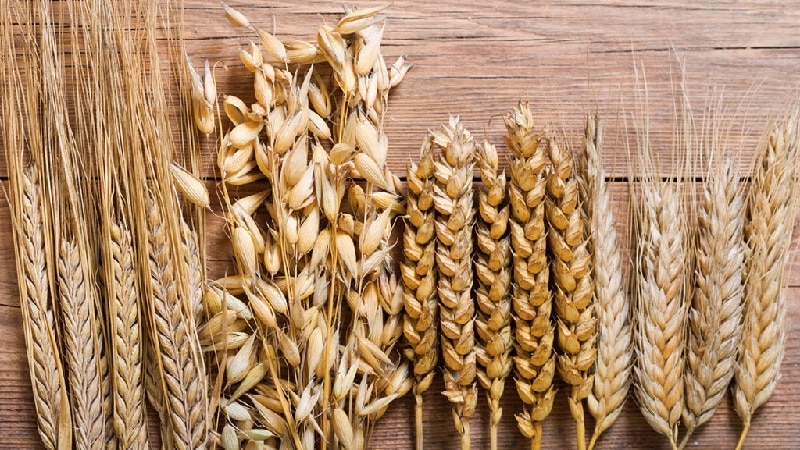
Which is more harmful?
Wheat flour has excellent taste and technological properties, but the higher the grade of flour, the less benefit it has. The highest grade and coarse grains are dominated by starch and gluten, but have little fiber and protein. Whole grain wheat flour contains vitamins PP, E, B1 and B2, but their amount decreases with intensive processing and disappears in higher grades.
Small wheat grains such as semolina and couscous cannot be called healthy food: they are high in calories and poor in chemical composition.
Reference! As a healthy side dish, it is better to choose spelt or spelt - a grain of semi-wild wheat that retains the beneficial properties of the whole grain.
Features of application
Grain crops are used in various areas of the national economy: from food production to pharmaceuticals.
Wheat is applied:
- for the production of flour, bread and pasta (from hard varieties), confectionery products (from soft varieties);
- as cereals: semolina, couscous, bulgur, freekeh;
- as a forage crop (straw, haylage);
- as a flavor enhancer: monosodium glutamate was derived from wheat protein, but in modern production soy is used for this;
- for preparing alcoholic drinks: beer, vodka and whiskey.
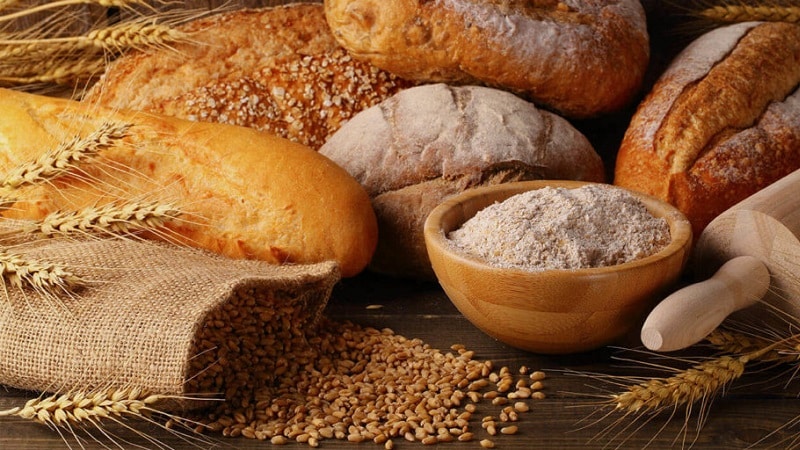
Scope of application of barley:
- pearl barley and barley grains (barley is crushed, unpolished kernels, pearl barley is whole, peeled and polished grains);
- Barley flour is added when baking; it is not used in its pure form, as the bread will crumble and quickly become stale;
- coffee substitute, which does not contain caffeine;
- malt production from sprouted grains, mainly for brewing;
- food grade green alcohol for making Scotch whiskey and English gin.
Unrefined grain and straw serve food for animals.
Oats are best known as:
- oatmeal - rolled oats, muesli flakes;
- flour, which is added to bread and confectionery;
- animal milk substitute - oat milk;
- compound feed and concentrated animal feed;
- sports nutrition supplement;
- raw materials in the alcohol industry: beer and mash are made from cereals (until 1975 whiskey was made from it).
Rye is used:
- for baking bread (a distinction is made between seeded, peeled and wallpaper flour);
- for the production of alcohol with the lowest content of fusel oils;
- for starch production;
- as a fodder crop;
- as green manure.
What's best for losing weight
From cereals produce a wide variety of products that contain ingredients that do not promote weight loss. Any confectionery or instant food products will not be dietary, even if they are made from the healthiest grains. Alcoholic drinks cause irreparable harm to health.
Wheat flour products are the most caloric and contain the maximum amount of gluten. However, sprouts and whole grain cereals - spelt - help normalize weight.
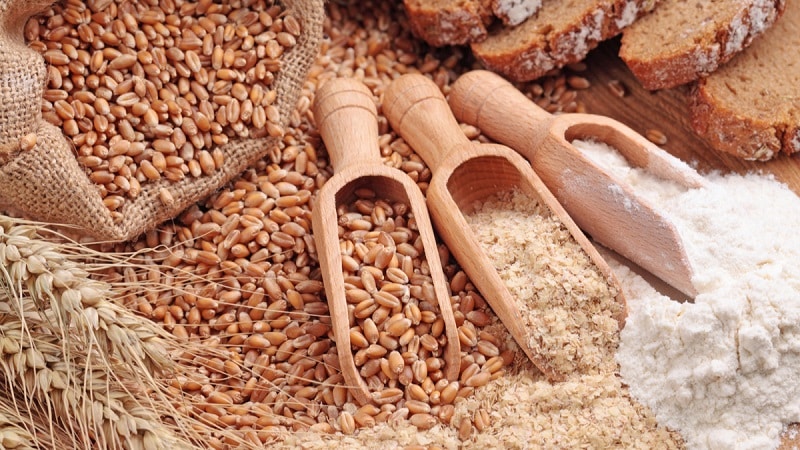
The difference between wheat and barley is that the latter contains little starch and a lot of fiber, which makes it a popular dietary product. Barley is especially useful: it is an unpolished grain that improves intestinal motility. Barley is no less valued: it takes a lot of time to digest, which means it fills you for a long time.
Oatmeal and decoctions are used for weight loss. They not only promote weight loss, but also improve intestinal function and normalize fat metabolism. The famous diet of Pierre Dukan recommends daily consumption of up to 3 tbsp. l. oat bran. A mono-diet based on this grain is popular.
Rye bread made from wholemeal flour and naturally leavened - an original dish of Russian peasants. In a number of countries (Germany, Poland and Scandinavian countries), cereal products are included in the group of healthy and dietary nutrition. Rye grain contains the highest amount of fiber and the least amount of gluten. This makes it an indispensable product in the diet of diabetics.
The less grain is processed, the higher its fiber content. and richer chemical composition. However, not a single product will bring the desired weight loss if the recommended norms of KBZHU (calories, proteins, fats and carbohydrates) are not met.
Conclusion
The main indicators of the benefits of cereals for the human body are the presence of dietary fiber, vitamins, minerals and other substances. Whole grains of wheat, rye, oats and barley have a rich composition and have unique properties, but during heat treatment they lose a significant part of them. This applies to wheat flour and semolina, instant oatmeal.
Those who care about their health are advised to include yeast-free rye bread, barley groats and coarse rolled oats in their diet.